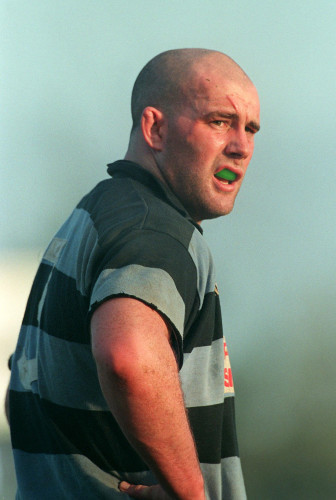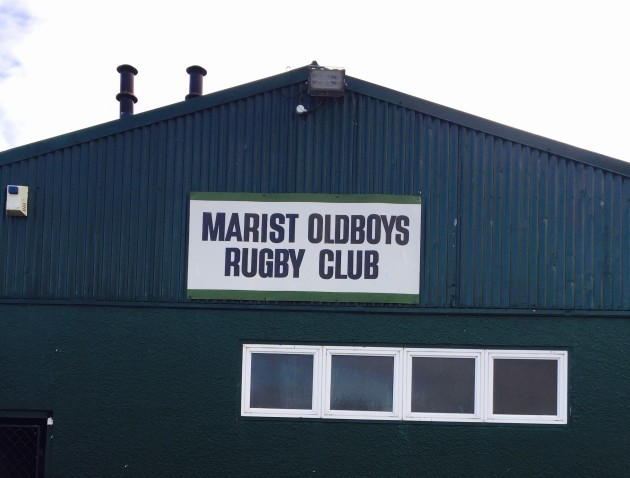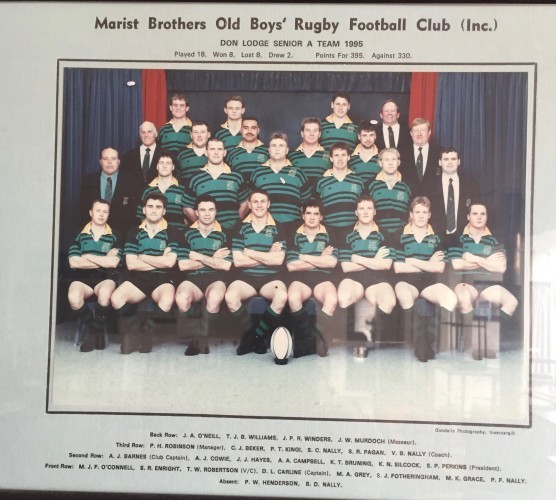Murray Kinsella reports from New Zealand
THEY REMEMBER JOHN Hayes fondly down in the Marist club in Invercargill, and they take a fair bit of pride in what the Bruff man went on to achieve after they converted him into a prop.
105 Ireland caps, a Grand Slam, two Heineken Cups with Munster, two Lions tours – the Bull earned his legendary status.
Hayes might never have enjoyed that success but for his two-season stint with Marist, where he arrived in 1995 as a 21-year-old second row who was still learning the game of rugby.
“John came to the club and we had him playing lock,” says current Marist president Bill Dowling. “Eventually, we said he would be better at prop. He went back to Ireland and the rest is history!”
Hayes had famously taken up the sport at the age of 18 with Bruff RFC and gone on to play AIL for Shannon, but he was still a novice when he landed in New Zealand to learn the ropes.
“He was like a big baby and we had to burp him on his first rugby trip!” recalls one of his Marist team-mates at that time, Jeremy Winders, who is a legend of Southland rugby.
“He just arrived at training, a big man with an Irish accent. In those days he was a lock but he didn’t understand the game very well. He was green as hell but he was keen to learn.”
Indeed, it was Hayes’ desire to improve as a rugby player that had brought him to New Zealand, with former Bruff player Kynan McGregor – a Kiwi and a Marist man – making the link for him.
Marist coach Vin Nally happened to be in Ireland at the time Hayes asked McGregor if they’d take him in New Zealand, and Nally told the gentle giant he was welcome to come down and give it a shot.
Marist has a history of Irish players in their ranks, including former Munster captain Pat Murray, Dave Dineen, Derek Tobin and Seamus Twomey – they currently have three Irishmen in their senior team – so they were only too happy to accommodate Hayes.
Invercargill is the southernmost city in New Zealand and one of the southernmost in the world, with a population of around 50,000.
“It’s not quite the end of the world down here, but by hell you can just about see it,” says Winders.
It was a huge move for Hayes – as he recounts in his autobiography The Bull, he had never been on an airplane before jetting to New Zealand – and Winders says the Irishman took his time to get settled off the pitch.
“He was very straight-laced at the start, wouldn’t drink and was very clean living. He was over here for one reason – to be a rugby player. At first, he was trying too hard but we got him to relax and enjoy himself.”
Once Hayes began to feel at home, the rugby followed. Hayes played in the second row in his first season with Marist and soon began to make a big impression with his 6’4″ frame.
“John’s rugby just fell into place and it was like ‘Where has this boy come from? This boy is really, really good.’ He trained really hard,” says Winders.
“He would throw tin around in the gym and people used to go up there and watch him. He was just so powerful and naturally strong in the gym.”
With his diligent approach and good eating habits, Hayes began to pack on weight and become an even more imposing figure.
New Zealand rugby is now better known for its sheer skill levels but traditionally Kiwis were all about physicality and fronting up. Club rugby in this part of the world was brutal in the amateur days and that remains the case in many regions today.
For Hayes, it proved to be a vital learning ground and he went on to play for the Southland U21s by the end of the season.
“He developed his confidence and his attitude and he became a bully on the field, which was good,” explains Winder, whose nickname around Marist – Marist Old Boys Rugby Football Club Invercargill to give the club its full name - is the Chosen One.
“At the start he wasn’t intimidating at all, even with his big frame, so we taught him how to be a bully, own your position and dominate – the way to get respect.
“He figured out that that was New Zealand rugby, and then the pace of it and the skill level too. Once he had that, he just loved it. It was his passion to go out there and hurt people, and he did.
“Oh he really did! He made the opposition’s lives miserable sometimes. He’d go out and destroy them physically and mentally for 80 minutes.”
Hayes proved to be something of a curiosity off the pitch, particularly as he refused the many offers of a pint in his first season.
Marist have a strong Polynesian and Maori influence and they were all about singing and celebrating after games, and though Winders jokes that Hayes “was not a very good Irish singer” the big Bruff man got involved.
His “beautiful accent” was popular around the club, even if Winders laughs about how Hayes could never get his surname right and called him ‘Winters’ instead.
He also recalls Hayes’ sister, Rosemary, visiting Invercargill and checking to make sure he was still going to church, again much to the laughter of his new team-mates.
Hayes worked in a tannery owned by former All Black and Southland legend Jack Hazlett to pay his way, and Winders and everyone else came to view the the Bull as a good friend, whose intimidating size came in useful on many occasions, even socially.
“He was good when there was a queue to go into a bar or a hotel. John would just bowl his way through and you’d just walk in behind him!
“I remember walking home with John one night after we’d been at the pub. I got picked on by a couple of young fellas while John was having a pee down an alleyway.
“John was peeing and these guys wanted to have a fight with me, and they were picking on me because I had a suit on. I think we had been to a funeral.
“I never wanted to fight anyone in my life, but this time I thought, ‘What the hell? This might be the time to have a fight. I’d love to have a fight’ because I had John there.
“I shouted for him, ‘John, are you finished?’
“John shouts back in his Irish accent, ‘What? What?’ and he’s coming down the alley. He says, ‘What the fuck do you want Winters?’ – he still couldn’t get my name right.
“I said, ‘John, I think I’m in trouble here, I think I need a hand.’
“He was doing up his fly coming around the corner and he looks up and these kids see him and go, ‘Ah, shit’ and they turned and did a runner.
“They’d never seen anyone so big and they just ran! I was gutted because it was going to be the first fight of my life and with John there I’d be able to say I’d won a fight. That was a real disappointment!”
While he made lifelong friends in Invercargill, his rugby adventure took an unexpected twist that proved to be to the long-term benefit of Irish rugby.
It was heading into his second season with Marist that the idea of Hayes moving into the front row first came about.
The laws in rugby were changing as it professionalised, with lifting properly introduced in the lineout, having crept in unofficially for a few years. Suddenly, Hayes was a very heavy lock and throwing him up at lineout time proved a problem.
“He was hopeless, we couldn’t even lift him off the ground!” says Winders. “He was 115kg or more and meant to be a lock, but we couldn’t lift him.”
There was a brains trust that saw propping potential in Hayes, despite his height. Marist coach Nally, scrum coach Doc Cournan, and the late Hazlett and Roger Ramsey – both of them Southland heroes – were all involved in the transition.
“They said, ‘This will be the future for this boy’ and we all sort of laughed at the start, because John was so big, too tall.”
There were some tough lessons for Hayes in the early days as he became a loosehead – he later moved to tighthead with Shannon – and he spent the season shifting between second row and front row, gradually getting comfortable with the new demands in the scrum.
“He just learned how to scrummage and hurt people, get a bit of attitude, then he found his spot and he could lift in the lineouts, away you go,” says Winders.
They saw the real potential in Hayes at Marist and coming toward the end of his time in New Zealand before returning to Shannon, the likes of Nally and Ramsey were telling him he could go on and play for Ireland as a prop.
Hayes headed back home to Shannon at the end of the 1996 season to take Irish rugby by storm, but the family was represented in Marist again in 2001 when younger brother Michael had his own stint, helping them to their first Galbraith Shield in 22 years.
This season, the Irish link in Marist is continuing with former Crescent College halfback Matt Hanly starring for them, Bray man Karl Townsend-Smyth shining in midfield and Wicklow lock Liam Gaffney adding a hard-nosed edge up front.
“We’re enjoying having the guys here,” says Dowling. “It’s hard these days and all grassroots rugby is struggling a wee bit. But the Irish guys add a flavour, a real atmosphere and it’s been fantastic having them here.”
Marist will be in contention for the Galbraith Shield again this year, and with a supporters’ club of around 130 people, they remain a proud club.
With Hayes having proven such a popular figure, their doors will always be open to Irish players.
“The club loved him, we just loved him,” says Winders. “He was a good man to play with, nobody messed with us because John was there.”
And like most rugby fans in Ireland, they remember Hayes as a good person and a giant who dominated opponents but always played by the laws.
“John was well-behaved, because he could have hurt people badly. Rugby was different in those days, there was rucking and a lot of fighting going on, but he didn’t go in for that.
“It’s a completely different game now, but those were the days of mud paddocks down in Waikako and places like that. That’s where John learned his trade.”
The42 is on Instagram! Tap the button below on your phone to follow us!





